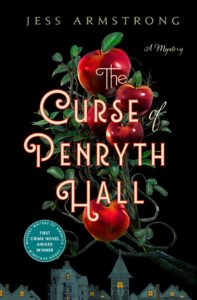This was an interesting and unexpected read. Set just post WWI, it’s the story of Ruby Vaughn, an orphaned heiress who makes a living selling books. She works for an elderly Exeter bookseller, and as the novel opens, he’s sending her to Cornwall to deliver a trunk full which he warns her not to open. Mystified, she complies. The village where he’s sending her is the home of her former best friend and perhaps former lover, Tamsyn. Tamsyn is married to Sir Edward Chenowyth of Penryth Hall, a marriage that broke their friendship.
As Ruby arrives in town she spots her old friend, Tamsyn, holding her toddler. From afar, she’s a vision; up close, it’s clear there’s something very wrong, as she sees bruising on her friend’s face and she’s a shadow of her former self. Never a fan of Edward, Ruby quickly assumes the worst, as does the reader. In every case in this book, reader, you will probably be wrong in your assumptions, which is what makes this a confounding reading experience.
The books delivered, Ruby spends the night at Penryth Hall, and wakes the next morning – after an uncomfortable and unpleasant dinner with Tamsyn and Sir Edward – to hear the pealing of bells. As Ruby goes to investigate, she discovers the housekeeper, who leads her to Sir Edward’s mutilated corpse. While Ruby was not a fan of the man, she’s still loyal to Tamsyn, and is drawn into the investigation surrounding his death.
The other person involved in the investigation turns out to be the person she’s delivered the books to, Ruan Kivell, who turns out to be the community Pellar, or local witch. It’s Ruan who examines the body first. The housekeeper insists it’s the curse of the hall returning after a thirty year abeyance, but Ruby and Ruan are pretty sure there’s a human hand at work.
Armstrong wants readers to make up their own minds from evidence presented. She presents the fact the Ruby and Ruan feel some kind of connection – he can literally “hear” her thoughts – and the fact that’s he seems to be able to perform some feats that can perhaps be only ascribed to witchcraft. Ruby is always skeptical, and she’s always looking at the human, not the supernatural, side of the coin, though she’s reluctantly coming to see that Ruan has some skills.
While this is set after the war, the feeling to me was more Victorian, and perhaps out in the English countryside in the 1920’s, that may have been the pervading feeling. The time period was the least interesting aspect of the book (unfortunately) as I picked it up wanting the experience of a read about a feisty Exeter bookseller in the 20’s. However, I enjoy being surprised at times, and this was one of those times.
It’s really a character study. Ruby is so young, and despite the experiences of the war that have left her alone in the world, she still has much to learn, very much including figuring out relationships. Her primary relationships in the book involve Tamsyn and Ruan, two very different characters who present Ruby with very different questions and issues to sort through. She doesn’t have much time to sort through her feelings as this fast paced story doesn’t let up. She’s made to sort her feelings on the fly and she’s really not very good at it, though she does at last twig to the culprit.
This was a fey coming of age story loaded with folklore and the feel of the English countryside. I really enjoyed both Ruby and Ruan; like Ruby herself, I went back and forth on Tamsyn, which shows some real skill on the part of the author as she manipulates the reader without seeming to do so. I would be very much interested in the next installment of this series. — Robin Agnew
